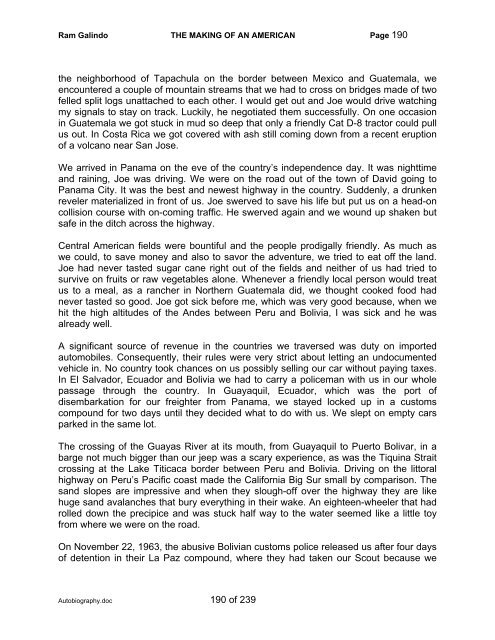Autobiography - The Galindo Group
Autobiography - The Galindo Group
Autobiography - The Galindo Group
Create successful ePaper yourself
Turn your PDF publications into a flip-book with our unique Google optimized e-Paper software.
Ram <strong>Galindo</strong> THE MAKING OF AN AMERICAN Page 190<br />
the neighborhood of Tapachula on the border between Mexico and Guatemala, we<br />
encountered a couple of mountain streams that we had to cross on bridges made of two<br />
felled split logs unattached to each other. I would get out and Joe would drive watching<br />
my signals to stay on track. Luckily, he negotiated them successfully. On one occasion<br />
in Guatemala we got stuck in mud so deep that only a friendly Cat D-8 tractor could pull<br />
us out. In Costa Rica we got covered with ash still coming down from a recent eruption<br />
of a volcano near San Jose.<br />
We arrived in Panama on the eve of the country’s independence day. It was nighttime<br />
and raining, Joe was driving. We were on the road out of the town of David going to<br />
Panama City. It was the best and newest highway in the country. Suddenly, a drunken<br />
reveler materialized in front of us. Joe swerved to save his life but put us on a head-on<br />
collision course with on-coming traffic. He swerved again and we wound up shaken but<br />
safe in the ditch across the highway.<br />
Central American fields were bountiful and the people prodigally friendly. As much as<br />
we could, to save money and also to savor the adventure, we tried to eat off the land.<br />
Joe had never tasted sugar cane right out of the fields and neither of us had tried to<br />
survive on fruits or raw vegetables alone. Whenever a friendly local person would treat<br />
us to a meal, as a rancher in Northern Guatemala did, we thought cooked food had<br />
never tasted so good. Joe got sick before me, which was very good because, when we<br />
hit the high altitudes of the Andes between Peru and Bolivia, I was sick and he was<br />
already well.<br />
A significant source of revenue in the countries we traversed was duty on imported<br />
automobiles. Consequently, their rules were very strict about letting an undocumented<br />
vehicle in. No country took chances on us possibly selling our car without paying taxes.<br />
In El Salvador, Ecuador and Bolivia we had to carry a policeman with us in our whole<br />
passage through the country. In Guayaquil, Ecuador, which was the port of<br />
disembarkation for our freighter from Panama, we stayed locked up in a customs<br />
compound for two days until they decided what to do with us. We slept on empty cars<br />
parked in the same lot.<br />
<strong>The</strong> crossing of the Guayas River at its mouth, from Guayaquil to Puerto Bolivar, in a<br />
barge not much bigger than our jeep was a scary experience, as was the Tiquina Strait<br />
crossing at the Lake Titicaca border between Peru and Bolivia. Driving on the littoral<br />
highway on Peru’s Pacific coast made the California Big Sur small by comparison. <strong>The</strong><br />
sand slopes are impressive and when they slough-off over the highway they are like<br />
huge sand avalanches that bury everything in their wake. An eighteen-wheeler that had<br />
rolled down the precipice and was stuck half way to the water seemed like a little toy<br />
from where we were on the road.<br />
On November 22, 1963, the abusive Bolivian customs police released us after four days<br />
of detention in their La Paz compound, where they had taken our Scout because we<br />
<strong>Autobiography</strong>.doc 190 of 239


